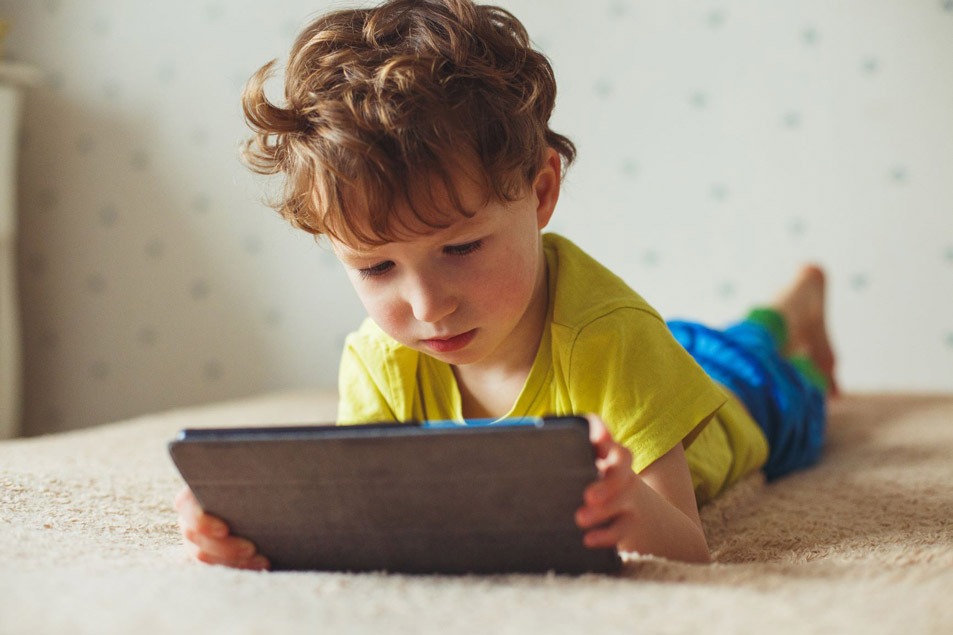The concept of screen time is also changing. Kids used to spend their screen time watching TV. Now with computers children and teens are not really watching as much TV, although they are watching shows on their computers. And of course they’re watching YouTube! They’re also on Instagram and Snapchat. Plus, a lot of their schoolwork and homework is done on the computer.
All of this changes how we look at screen time.
Changing Times and a New Way to Look at Screen Time
In the past, the recommendation was two hours of screen time a day, and that was pretty straightforward. Nowadays, if we set a two-hour limit a lot of kids would hit that before lunchtime because they’re doing homework on screens in their classrooms. So we have to look at screen time differently. Rather than a specific number of hours per day, we need to look at what types of media children are using and the value of the interaction.
Think of Screen Time like the Food Pyramid
There are things we should have sparingly and there are things that should fill more of our plate.
At the top of the pyramid, the fats and sweets of screen time use, is mindless watching. This is where a child sits in front of the TV (or on an iPad or computer) and watches cartoons. This is fine when parents need to make dinner, or the child needs a break to watch their favorite show. It’s just not something you want to do all the time.
Below that on the food pyramid I think of watching shows with your child. This is better because you’re able to engage with your child. Instead of your child just sitting there, you can enjoy the show with them. You can ask, “What would you do if that happened to you?” Or, “What do you think she’s going to do next?” This creates a conversation and encourages your child to think about different things while watching something fun.
Below that, and even better, are educational games where your child can either learn something or solve puzzles. This engages your child’s mind. So when you’re breaking up screen time, you can allow more time for activities versus mindless show watching.
Guidelines for Screen Time by Your Child’s Age
Under 18 months
Use screens as sparingly as possible. Sometimes younger children will be exposed to screens when older siblings are watching TV or are on the computer. I would try to be aware of this and prevent it from happening as much as possible.
Around age 2
You can start to introduce screen time. I encourage parents to be very consistent and thoughtful about what types of digital media your children are exposed to. Giving a child a cell phone at a restaurant to help them wait until the food arrives, that’s fine. I worry more when kids are at home and instead of playing with a parent, sibling or toy, they’re in front of a TV or tablet.
Early Tweens and Older Children
Starting in the early tween years (and even around age 8), I would definitely have a very close eye on your child’s screen time use. This is where children develop a lot of habits they might have for the rest of their life in terms of screen time and the way they interact with others online.
For older kids, there’s Instagram, Snapchat and a million other social media platforms. Being very careful about how much time you allow your child to have on these platforms is critical. It’s also important to make sure they aren’t replacing all of their interaction with their friends and peers with online interaction.
Guidelines for parents:
- Know your child’s passwords
- Be able to look at their phone/device at any time
- All devices should sleep, meaning charge somewhere other than the bedroom so notifications don’t disrupt sleep
- Children should use their screens in public places in the house, the family room or kitchen table
Setting guidelines gives your child some autonomy and also protects them from some of the dangers that exist with social media.
Be a Role Model
The other thing I share with parents is being a role model for your child. So if I as a parent tell my children to get off their screens, but then I’m getting notifications and looking at my phone at the dinner table, or pulling my phone out when we’re having family time, I’m not modeling what I want my children to do.
It’s very important to have time where we say no phones, and we put them in a basket or a different room, and sit down for dinner or a nice conversation without anyone getting notifications or hearing text message dings. We have to model self-control as parents and say, “Okay, I’m going to put my phone on silent so we can talk, relax, watch this show together, read books or go play outside.” This shows your child what’s important to you.
Set Family Rules for Screen Time
Whatever you decide for your family, I encourage you to sit down and talk about it together, write it on a piece of paper, put it on the fridge and say, “This is our plan for screen time.” It shows your children that screen time is important for all of us.
Setting rules for everyone, and modeling that behavior as parents, reinforces that while screens are useful and have a lot to offer us, there are more important ways to interact and more important things to do than be consumed with our screens all the time.
Join our Facebook Group
Join today, start learning and connecting with other parents.

Phil Boucher, MD
Pediatrician with Lincoln Pediatric Group.









